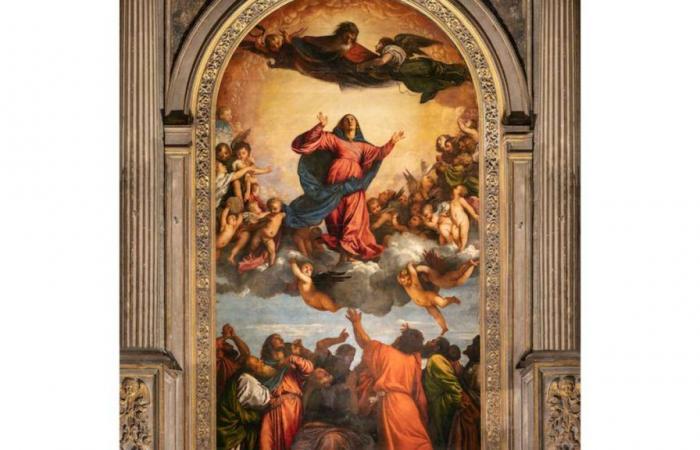“The Assumption of the Virgin” (1518) is located in the Basilica S.Maria Gloriosa dei Frari, in Venice.
Photo: Courtesy Cineco Alternativo
The feet of Mary rested on a cloud raised by angels, who, with open arms and gaze at heaven, waits for God to welcome her into his kingdom. She is in the center of the composition, surrounded by cherubs and with a halo of light behind her. Clouds divide the space between heaven and earth in this representation of the biblical passage “Assumption of the Virgin” by Italian artist Tiziano Vecellio.
The oil painting was unveiled in May 1518 and marked Titian’s first major commission, one that brought him stardom in Venice. The work is located in the Basilica of Santa María Gloriosa dei Frari and from there begins the journey on which the documentary “Tiziano: the empire of color” embarks.
The idea for this film came from producers Marco Caberlotto and Lucio Scarpa. “They previously made a film about Tintoretto, who is another Italian Renaissance painter, and then they wanted to make this film about Titian,” explained Giulio Boato, one of the directors of the documentary. The director began touring Europe in search of some of the settings where the painter’s works are found.
The countries that were once empires, such as Spain, France and England, and the city-states that are today Italy, remain the homes of the empire of color that Titian left behind in his paintings. Boato toured these places and interviewed several experts to learn about the indelible mark in oil paintings that Titian left. In addition, he filmed in extreme detail around 50 paintings by the artist, made throughout his entire career.
“Bacchus and Ariadne” (1520–1523) is in the National Gallery in London, England.
Photo: Courtesy Cineco Alternativo
There were many witnesses to the brushstrokes of the Italian master who, for decades, developed his work. The years of his life allowed him to mature his style and technique, and cause a stir in the art world of the 16th century, something that was perpetuated centuries after his death, as he has been called “the impressionist of the century.” XVI”. According to art curator Jaime Cerón, this can be seen in his late work, where the artist moved away from the perfection that had marked the art of the past and “relaxed” in terms of his brushwork that is seen in “the late works that seem a little sketched like the works of Velázquez Velásquez and Goya. Up close you can see the brush strokes and paint marks, although the art of the 19th and 20th centuries was also centuries away. I think it is inherent to the exercise of searching, in a certain way, it forms a spontaneous imprint on the reality of the images,” Cerón stated.
“The production company Sky likes to film documentaries with a recreation line, which gives a more emotional part to the historical. My goal was to find a modern way to tell the artist’s story. That could not only be done with a historical recreation, but also with an emotional narrative,” said Laura Chiossone, the other director of the documentary, who was in charge of the dramatic recreations in the documentary.
“Sacred Love and Profane Love” (1514) is in the Galleria Borghese in Rome, Italy.
Photo: Courtesy Cineco Alternativo
“I tried to work on symbolism, metaphor and details. So it is not a real historical recreation, but rather an emotional one. I tried to get into the head, heart and soul of Titian. “I tried to find the key point in his life that I couldn’t give an explanation for, but that made the viewer feel closer,” added the director.
Chiossone explained the growing trend of dramatic reenactments in documentaries. “Film is an emotional language, so if you just make a documentary where people talk and you show the paintings, it’s colder. But if you try to capture them with music, symbols and emotions you can bring them inside, to an emotional point of view that is more interesting. I think otherwise you can go to university and listen to a lesson about the painter.”
Although centuries have passed since Titian last used a brush, his imprint and legacy have remained points of reference throughout the centuries. According to Cerón, the influence of Italian in the art world became clearer towards the end of the 19th century.
The work “Venus of Urbino” (1538) is in the Uffizi Gallery in Florence, Italy.
Photo: Courtesy Cineco Alternativo
“Around 1880, Edouard Manet painted Olympia, which is a, let’s say, vulgarized and totally contemporary version of Titian’s “Venus of Urbino.” The Italian version has some features of the goddess, which makes it incorporated as an ambivalent idea between a myth or an idea. It would make sense that these gestures were the signs so that a 16th century viewer could know that she was a goddess of love. Manet takes that into consideration, but he tries to bring it literally to reality and uses the same pose, the same composition, but he hires a prostitute as a model, who was a literal goddess of contemporary love. Critics of the time said that the work smelled rotten, because one imagined the mortality of the model who in the past seemed immortal. I think that is like a crack through which one can go to look at performance in the 20th century, the use of the nude in performance that has transversive purposes, either sometimes alluding to the connection with sexuality or other times alluding to the patriarchal gaze on the female body that prevents us from seeing aspects that are not inherent to the sexualization of women or their interpretation as mothers,” stated the curator.
The documentary is a new way to get to know the painter and his empire of color, which although it remains current, it is good to continue having it on the artistic horizon. “In Italy we always studied art, so he knew some of Titian’s paintings, but he knew absolutely nothing about his life and career. It was very inspiring to see him and talk to those people who know him. And with Jeff Koons, it was fantastic to hear from a living artist how he feels about someone from 500 years ago,” Boato concluded.
Making the documentary left a lesson for the two directors. For Boato it was “never give up”, the artist had many obstacles in his goal of becoming the legend he is today. Chiossone, for his part, thought about the idea of “continuing his path. “To go conquer the whole world and find a way to express oneself in art.”
“Tiziano: the empire of color” is part of the Cineco Alternativo cycle “Great Italian Masters”. The documentary will be presented on June 21, 22 and 23 in eight cities in Colombia: Barranquilla, Bogotá, Bucaramanga, Cali, Cartagena, Chía, Manizales and Medellín, with an additional date on June 24 in Bogotá, Cali and Medellín.






